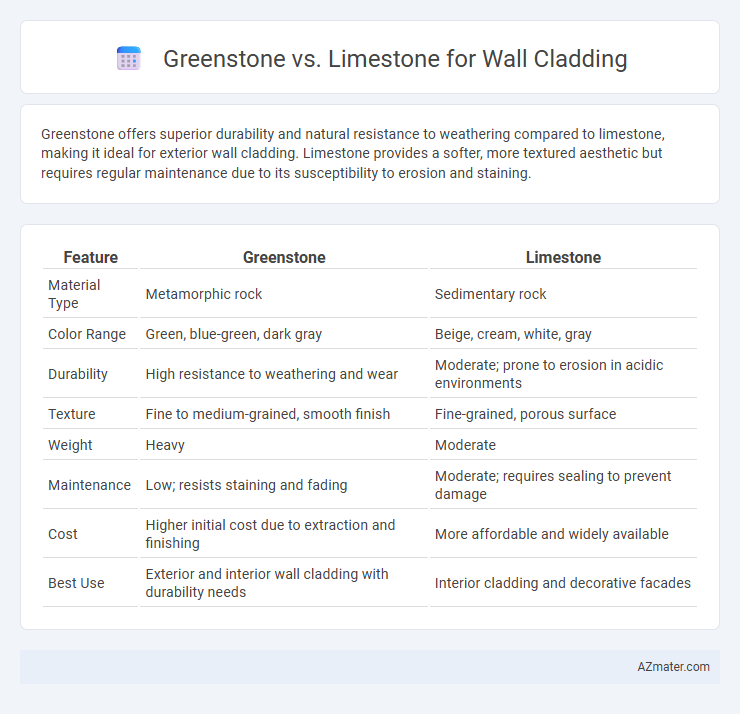Greenstone offers superior durability and natural resistance to weathering compared to limestone, making it ideal for exterior wall cladding. Limestone provides a softer, more textured aesthetic but requires regular maintenance due to its susceptibility to erosion and staining.
Table of Comparison
| Feature | Greenstone | Limestone |
|---|---|---|
| Material Type | Metamorphic rock | Sedimentary rock |
| Color Range | Green, blue-green, dark gray | Beige, cream, white, gray |
| Durability | High resistance to weathering and wear | Moderate; prone to erosion in acidic environments |
| Texture | Fine to medium-grained, smooth finish | Fine-grained, porous surface |
| Weight | Heavy | Moderate |
| Maintenance | Low; resists staining and fading | Moderate; requires sealing to prevent damage |
| Cost | Higher initial cost due to extraction and finishing | More affordable and widely available |
| Best Use | Exterior and interior wall cladding with durability needs | Interior cladding and decorative facades |
Introduction to Wall Cladding Materials
Greenstone and limestone are popular wall cladding materials known for their durability and natural aesthetic appeal. Greenstone offers a rich, earthy tone with high resistance to weathering, making it ideal for exterior applications. Limestone, characterized by its soft texture and neutral shades, provides excellent thermal insulation and is often favored for its classic, elegant appearance in architectural designs.
Overview of Greenstone and Limestone
Greenstone is a durable metamorphic rock known for its rich green hues and fine texture, often used in wall cladding due to its resistance to weathering and aesthetic appeal. Limestone, a sedimentary rock composed mainly of calcium carbonate, offers a classic, neutral palette with smooth surfaces, making it popular for both interior and exterior cladding applications. Both materials provide unique textural qualities and long-lasting performance, but Greenstone tends to offer higher durability in harsher environmental conditions.
Aesthetic Appeal: Greenstone vs Limestone
Greenstone offers a unique aesthetic appeal with its rich, deep green hues and textured surface, creating a striking, natural look ideal for modern and rustic wall cladding projects. Limestone, known for its soft, neutral tones ranging from creamy whites to warm beiges, provides a classic and elegant appearance that enhances both traditional and contemporary designs. The choice between Greenstone and Limestone for wall cladding ultimately depends on the desired visual impact and architectural style, with Greenstone delivering bold character and Limestone imparting timeless sophistication.
Durability and Strength Comparison
Greenstone offers superior durability and strength for wall cladding due to its dense, fine-grained composition, making it highly resistant to weathering and impact. Limestone, while aesthetically appealing with a softer texture, is more prone to erosion and surface damage under harsh environmental conditions. Choosing greenstone ensures longer-lasting structural integrity and minimal maintenance compared to limestone in exterior cladding applications.
Environmental Impact and Sustainability
Greenstone offers superior environmental benefits for wall cladding due to its natural durability and low maintenance requirements, reducing the need for frequent replacement and resource consumption. Limestone, while aesthetically appealing, often requires extensive quarrying and energy-intensive processing, leading to a larger carbon footprint. Choosing greenstone supports sustainable building practices by minimizing habitat disruption and promoting long-term ecological balance.
Weather Resistance and Maintenance Needs
Greenstone exhibits superior weather resistance compared to limestone due to its dense mineral composition, which resists moisture penetration and surface erosion in harsh climates. Limestone typically requires more frequent sealing and maintenance to prevent weathering effects such as spalling and discoloration caused by acid rain and freeze-thaw cycles. Choosing greenstone for wall cladding ensures longer-lasting durability and lower upkeep costs in environments prone to extreme weather conditions.
Installation Process and Costs
Greenstone wall cladding requires meticulous cutting and specialized tools due to its dense, hard texture, often resulting in higher labor costs compared to limestone, which is softer and easier to shape on-site. Limestone installation benefits from lighter weight panels that reduce transportation and handling expenses, while greenstone's durability demands more skilled labor, increasing overall project costs. Budget-conscious projects favor limestone for its lower installation complexity and expense, whereas greenstone is preferred for long-term durability despite higher initial investment.
Versatility in Architectural Applications
Greenstone offers exceptional versatility in architectural applications due to its rich color variations and unique texture, making it ideal for both modern and traditional wall cladding designs. Limestone provides a soft, natural aesthetic with excellent workability, allowing for intricate detailing and customization in various architectural styles. Both materials adapt well to interior and exterior cladding, but greenstone's durability and vibrant hues often make it preferred for high-impact, decorative facades.
Long-term Performance and Value
Greenstone offers superior long-term performance for wall cladding due to its high durability, resistance to weathering, and minimal maintenance requirements. Limestone, while aesthetically appealing and cost-effective initially, tends to be more porous and susceptible to erosion and staining over time, impacting its longevity and increasing upkeep expenses. Investing in Greenstone ensures enhanced value retention and reduced lifecycle costs for exterior wall applications.
Choosing the Right Stone for Your Project
Greenstone offers exceptional durability and a unique range of earthy tones, making it ideal for both modern and rustic wall cladding projects, while limestone provides a softer, more classic aesthetic with excellent workability for intricate designs. Consider project factors such as weather exposure; greenstone's high resistance to moisture and wear suits exterior applications, whereas limestone is better suited for sheltered or interior walls due to its porous nature. Ultimately, choosing between greenstone and limestone depends on desired texture, color palette, and environmental conditions to achieve long-lasting, visually appealing wall cladding.

Infographic: Greenstone vs Limestone for Wall Cladding
 azmater.com
azmater.com